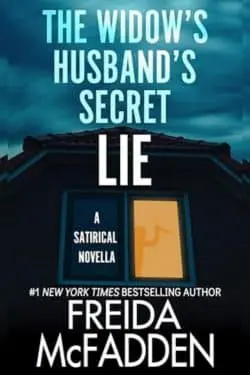Freida McFadden’s The Widow’s Husband’s Secret Lie is a novella that dares to step outside the conventional boundaries of the psychological thriller genre, delivering a satirical and humor-laden narrative. Known for her ability to craft suspenseful stories, McFadden takes a different route with this novella, infusing it with a satirical tone that both celebrates and critiques the genre. This review delves into the strengths and weaknesses of the novella, exploring its humor, narrative structure, and character development.
Plot Overview
The story centers around a widow who, after attending her husband’s funeral, begins to see his face everywhere she goes. What starts as a haunting psychological thriller soon reveals itself as a satire, poking fun at the genre’s common tropes. The widow’s journey is filled with absurd twists and turns that are meant to be both thrilling and amusing, challenging the reader’s expectations of what a psychological thriller should be.

Strengths
One of the novella’s primary strengths is its ability to blend humor with suspense. McFadden uses satire to deconstruct the typical elements of a psychological thriller, creating moments of genuine laughter alongside the tension. The humor is sharp and often comes from the absurdity of the situations the widow finds herself in, as well as the exaggerated characteristics of the supporting cast. For readers familiar with the genre, these satirical jabs can be particularly entertaining, offering a fresh perspective on the familiar narrative arcs.
Character Development
In keeping with the novella’s satirical tone, the characters in The Widow’s Husband’s Secret Lie are exaggerated to the point of being caricatures. This approach works well in the context of the story, where the humor often stems from the characters’ over-the-top personalities and actions. However, this also means that the characters lack the depth typically expected in a psychological thriller. The widow, for instance, is portrayed as somewhat naive and easily flustered, a choice that serves the satire but may leave some readers wishing for more complexity.
Pacing and Narrative Structure
The pacing of the novella is another area where opinions may diverge. Some readers might find the uneven pacing to be a detriment, with certain sections feeling dragged out while others rush through key plot points. This inconsistency can make the narrative feel disjointed at times, which may affect the overall reading experience. The novella’s structure, however, is cleverly designed to build up to a series of twists that, while predictable, still manage to entertain thanks to the satirical lens through which they are presented.
Weaknesses
While the satire is often clever, there are moments where it falls flat. The humor occasionally relies on overused tropes that might feel tired rather than refreshing. Additionally, the novella’s tone can be confusing, especially for readers who are not immediately aware that the story is intended as a satire. This tonal inconsistency might detract from the enjoyment of those expecting a more traditional thriller experience.
Target Audience
The Widow’s Husband’s Secret Lie seems to cater specifically to fans of McFadden’s previous works, particularly those who appreciate her unique brand of humor. However, new readers or those unfamiliar with the author’s style may find the novella less accessible. The in-jokes and references might go over the heads of some readers, limiting the novella’s broader appeal.
Conclusion
Freida McFadden’s The Widow’s Husband’s Secret Lie is a bold experiment that blends satire with the psychological thriller genre. While it succeeds in delivering humor and clever commentary, it also has its shortcomings, particularly in character development and pacing. The novella is likely to appeal to a niche audience, particularly those who enjoy McFadden’s previous works and appreciate the blending of genres. However, for readers looking for a more traditional psychological thriller, this might not be the best choice.
Also Read: The Seventh Veil of Salome: By Silvia Moreno-Garcia (Book Review)



